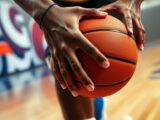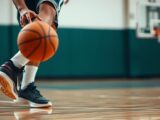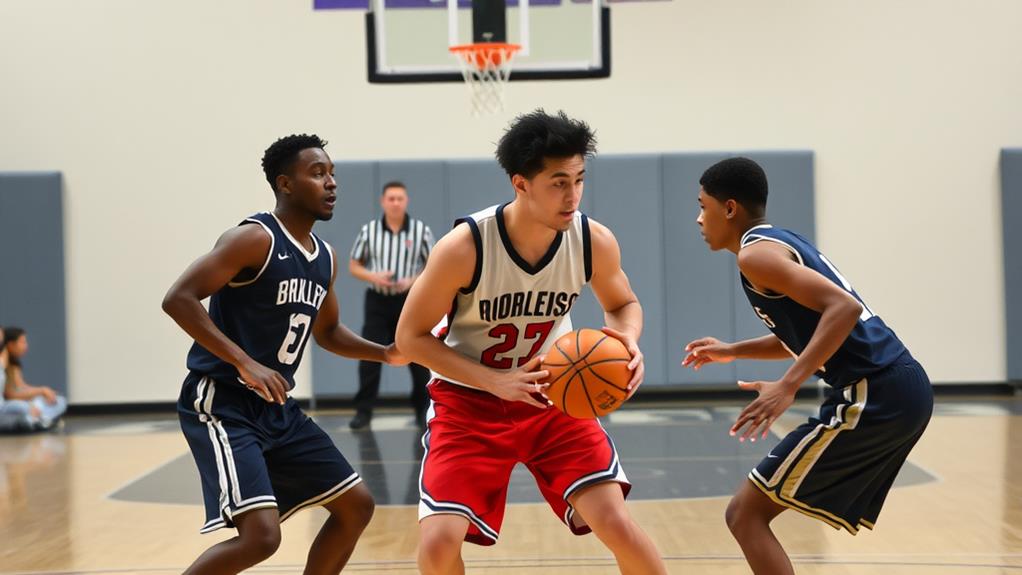
Double Dribble in Basketball: Rules and Examples
October 10, 2024In basketball, a double dribble violation happens when you stop dribbling and then start again without passing or losing control of the ball. This rule's designed to maintain fair play and team strategy, preventing players from gaining an unfair advantage. If you commit a double dribble, possession shifts to the opposing team, which can disrupt your game's momentum. To avoid this violation, focus on controlling the ball and making quick decisions. Practicing dribbling and passing can also help. There's more to discover about this rule and its impact on the game if you carry on!
Definition of Double Dribble
Understanding the double dribble is vital for any basketball player. A double dribble violation occurs when a player dribbling the ball stops, then resumes dribbling again without passing or losing control of the ball. This rule is essential for maintaining fair play and competitive balance in the game, much like the importance of field dimensions and equipment requirements in soccer.
Once your first dribble has ended, you can't just start dribbling again unless another player touches the ball.
This violation in basketball is particularly common in youth basketball and high school games, where players are still mastering the rules. New offensive players often struggle to remember this rule, leading to turnovers and lost possessions of the ball.
Experienced players, however, usually have a strong grasp of the double dribble rule and work hard to avoid it, recognizing how it disrupts gameplay.
In all major basketball leagues, including the NBA, NCAA, and FIBA, the enforcement of this rule helps maintain the integrity of the game.
Reasons for Double Dribble Violation
Double dribbling often stems from players losing track of the game's flow. When players stop dribbling and then resume, it results in a double dribble violation, which disrupts the fairness of gameplay. This rule is in place to guarantee that offensive players don't gain an unfair advantage by reassessing their options without the pressure of active dribbling.
Allowing a player to regain control of the ball after stopping could lead to excessive ball hogging, especially by star players, undermining teamwork and strategic play. By utilizing data analytics to enhance player decision-making, teams can encourage quicker, more effective responses during gameplay.
The double dribble rule encourages quick decision-making and promotes passing, enhancing the overall effectiveness of the team. It pushes players to collaborate and maintain a fluid offensive strategy instead of relying solely on individual skills.
By enforcing this rule, referees help maintain the game's pace and guarantee that both offensive and defensive players can contribute effectively. Ultimately, the consistent application of this rule fosters a balanced competitive environment, where all players can showcase their skills while adhering to the fundamental principles of basketball.
This way, the game remains dynamic, guaranteeing that both teams engage in fair competition.
Penalties for Double Dribble
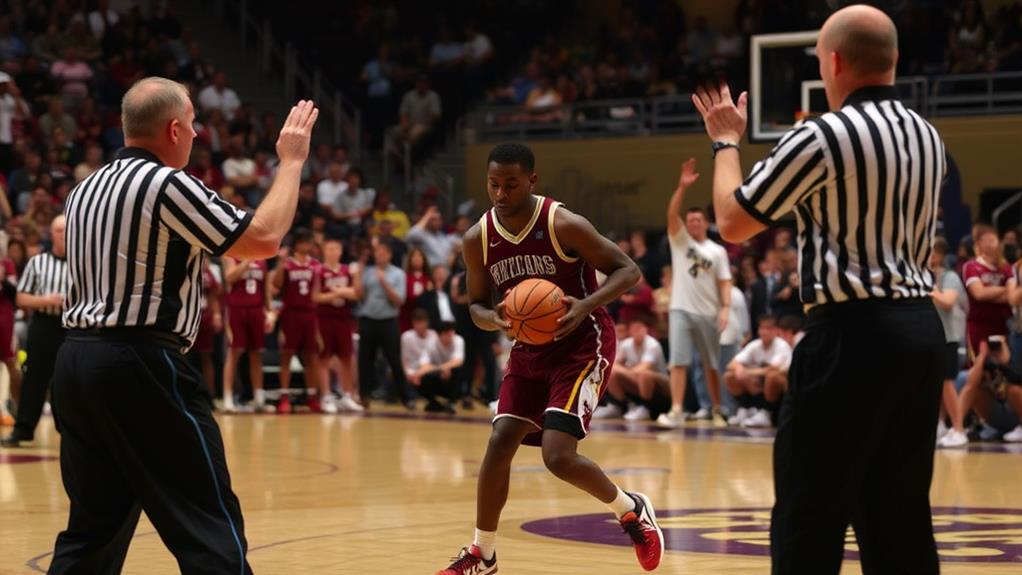
When a player commits a double dribble violation, the consequences are clear and immediate: possession of the ball shifts to the opposing team. This turnover can greatly impact the game's momentum, as it gives the opponents a chance to score.
According to the evolution of game regulations, enforcing rules like the double dribble helps maintain fairness and enhances the competitive aspect of basketball, as seen in ongoing rule changes. Under basketball rules, the penalties for a double dribble are straightforward. In high school and college games, the ball is inbounded at the nearest spot to where the violation occurred, allowing for a quick shift.
In the NBA, however, the ball must be inbounded between the free throw line and the baseline, creating a different strategic dynamic. Players need to maintain a controlled dribble to avoid this violation. When the dribble ends and they attempt to start dribbling again, it leads to the double dribble penalty.
Consistency in enforcing these rules across leagues like NCAA, NFHS, and FIBA helps promote fair play and competitive balance. Referees play a significant role in maintaining the integrity of the game by calling double dribble violations, making sure that all players adhere to the established guidelines.
Understanding these penalties is essential for players to avoid costly mistakes during a game.
Enforcement of Dribbling Rules
When you watch a game, you might notice that referees sometimes miss double dribble violations due to the game's fast pace.
This oversight is more common in youth games, where players are still mastering their skills, compared to professional matches where control is sharper.
Understanding these enforcement challenges can help you appreciate the nuances of gameplay and referee decisions.
Additionally, being aware of key regulations in basketball can enhance your viewing experience and understanding of the sport.
Referee Oversight Challenges
Often, referees struggle to spot double dribble violations during fast-paced basketball games. When a player touches the ball twice after ceasing their dribble, a violation occurs, but the intensity of the game can lead to missed calls. In professional leagues, the high skill level of players often minimizes these infractions, making them less noticeable to both referees and fans.
Referee oversight is heavily influenced by their positioning on the court. Being in the right place allows referees to observe the action more effectively and enforce dribbling rules consistently. However, when they're out of position, the likelihood of overlooking a double dribble increases, potentially compromising the game integrity.
It's important to recognize that while fans may feel double dribbles go unpenalized, studies indicate these violations are less frequently called than traveling calls.
Continuous training and education for referees on the nuances of dribbling rules is essential. This ongoing development not only sharpens their skills but also enhances their ability to guarantee players remain in control of the game and uphold its integrity.
Youth Vs. Professional Enforcement
In youth basketball leagues, the enforcement of dribbling rules, particularly double dribble violations, often falls short due to the inexperience of referees and players. Many youth players are still mastering the foundational tools of the game, which can lead to frequent double dribble incidents.
When a violation occurs, these inexperienced referees may overlook it, impacting the game's flow and fairness.
In contrast, professional referees in the NBA are trained to quickly identify double dribble violations, ensuring a more consistent enforcement of the rules. Although fans might think these infractions aren't often called, it's largely due to the players' advanced skills in maintaining control of a live ball.
The fast-paced nature of professional games can result in occasional missed calls, but overall, the decision-making process among referees is much sharper.
Youth players often struggle with decision-making after picking up the ball, leading to a higher number of dribbling violations.
Different leagues have specific enforcement rules regarding where the ball is inbounded after a double dribble, with youth leagues generally more lenient than the NBA's stricter guidelines.
Teaching Avoidance Techniques
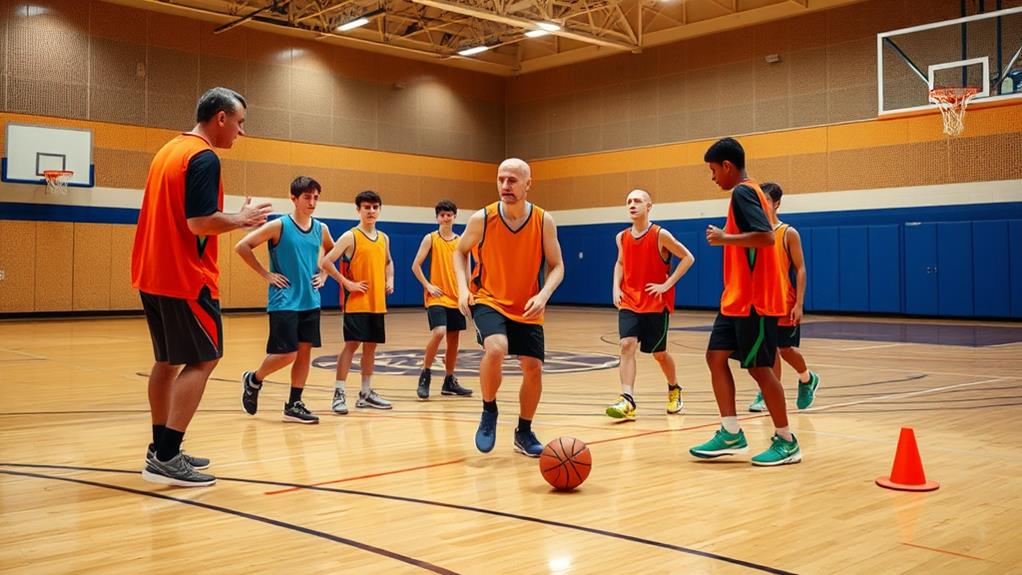
When you're teaching players to avoid double dribbles, focus on dribbling control techniques that keep the ball low and manageable.
It's also essential to incorporate strategies reflecting the evolution of defensive tactics, such as adapting to modern defensive demands that require players to make quick decisions under pressure.
Practicing game situations where they must make quick decisions can reinforce their skills and help them learn when to pass instead of dribbling again.
Dribbling Control Techniques
Mastering dribbling control techniques is essential for every basketball player to avoid costly double dribble violations. To maintain possession, you should focus on using one hand while dribbling. This helps prevent situations where a player can't resume dribbling after picking up the ball, which leads to a double dribble.
Understanding your pivot foot is vital; knowing when to pivot allows you to make informed decisions without resorting to a double dribble. Incorporate drills that emphasize dribbling mechanics, like control dribbling and speed dribbling, to enhance your ability to keep the ball alive during play.
During practice games, get immediate feedback when you pick up the ball. Remember, a second dribble can't be initiated unless another player touches it. This awareness will help you avoid committing mistakes.
Additionally, focus on recognizing when to pass instead of dribbling again. This not only promotes teamwork but also reduces the likelihood of double dribble infractions.
Practicing Game Situations
Practicing game situations is key to helping players develop the skills needed to avoid double dribble violations. In your practices and scrimmages, focus on scenarios where players simulate dribbling under pressure. This will enhance their decision-making abilities, allowing them to quickly assess passing options after picking up the ball.
To reinforce the double dribble rule, use frequent practice stoppages to correct players when they attempt to dribble again after stopping. This helps them understand the importance of maintaining control of a live dribble. Incorporate drills that emphasize awareness of their pivot foot and maintaining control to help them avoid situations that lead to double dribbling.
Encourage players to utilize passing over dribbling after a stop, promoting better teamwork and reducing double dribble violations. By creating game-like situations in practice, you'll prepare players to make quick decisions and react effectively during real games.
Related Concepts in Dribbling
Understanding the nuances of dribbling violations is vital for every player's development in basketball. One key aspect is the double dribble, which occurs when you dribble, stop, and then start dribbling again. It's essential to recognize that this isn't just a mistake; it's a dribbling violation that can turn over possession.
Another important concept is the carrying violation, which happens when you place your hands on the ball with your palm facing up. This illegal ball handling can disrupt your flow and lead to turnovers. In basketball, just as in soccer, adhering to rules guarantees a fair and competitive environment, as highlighted in match duration regulations.
By mastering these rules, you'll enhance your ball handling skills and improve officiating accuracy on the court. Familiarity with dribbling violations like double dribbles and carrying guarantees player compliance during games, promoting a fair playing environment.
Understanding rules surrounding these concepts can greatly impact your basketball strategy. Recognizing how these violations affect your decisions can elevate your overall performance.
Conclusion
In the thrilling world of basketball, avoiding a double dribble is like dodging a meteor hurtling toward Earth! Mastering this rule can elevate your game to epic proportions, transforming you from a mere player into a court legend. So, keep those dribbles clean and your moves sharp, or risk facing the wrath of the referee like a gladiator in the arena! With practice, you'll become a double dribble ninja, effortlessly gliding past defenders and dazzling the crowd!

